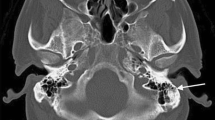Summary
In seven patients with temporal bone fractures examined by both CT and MRI, thin section CT proved superior to MRI in demonstrating the full extent of the fractures and the status of the ossicular chain. MR studies were able to demonstrate fractures, when these fractures contained blood or CSF, and the presence of ossicular dislocation in one case where the middle ear was completely filled with CSF or blood. Admixture of air in the middle ear gave a false impression of ossicular dislocation, while air in the fracture obscured portions of it. MR proved superior to CT in the evaluation of intracranial contents by showing 5 additional subdural hematomas, 2 epidural hematomas and 2 hemorrhagic contusions.
Similar content being viewed by others
References
Han JS, Kaufman B, Alfidi RJ, Yeung HN, Benson JE, Haaga JR, El Yousef SJ, Clampitt ME, Bonstelle CT, Huss R (1984) Head trauma evaluated by magnetic resonance and computed tomography: a comparison. Radiol 150: 71–77
Zimmerman RA, Bilaniuk LT, Hackney DB, Goldberg HI, Grossman RI (1987) Head injury: early results at 1.5 tesla. AJNR (in press)
Snow RB, Zimmerman RD, Gandy SE (1986) Comparison of magnetic resonance imaging and computed tomography in the evaluation of head injury. Neurosurg 18: 45–51
Gomori JM, Grossman RI, Goldberg HI (1985) High field magnetic resonance imaging of intractranial hematomas. Radiol 157: 87–93
Zimmerman RA, Bilaniuk LT, Hackney DB, Goldberg HI, Grossman RI (1987) MRI of paranasal sinus hemorrhage. Radiology (in press)
Holland BA, Brandt-Zawadzki M (1984) High-resolution CT of temporal bone trauma. AJNR 5: 291–295
Manelfe C, Cellelier P, Sobel D, Prevost C, Bonafe A (1982) Cerebrospinal fluid rhinorrhea: evaluation with metrizamide cisternography. AJR 138: 471–476
Schubiger O, Valavanis A, Stuckmann G, Antonucci F (1986) Temporal bone fractures and their complications. Neuroradiol 28: 93–99
Johnson DW, Hasso AN, Stewart III CE, Thompson JR, Hinshaw Jr DB (1984) Temporal bone trauma: high-resolution computed tomographic evaluation. Radiol 151: 411–415
Zimmerman RA, Bilaniuk LT (1986) MRI in subacute head injury. In: Proceedings of XII meeting of the European Society of Neuroradiology. Elsevier, Holland (in press)
Gomori JM, Grossman RI (1986) Mechanisms responsible for the MR appearance and evolution of intracranial hemorrhage. Radiology 161: 364
Author information
Authors and Affiliations
Rights and permissions
About this article
Cite this article
Zimmerman, R.A., Bilaniuk, L.T., Hackney, D.B. et al. Magnetic resonance imaging in temporal bone fracture. Neuroradiology 29, 246–251 (1987). https://doi.org/10.1007/BF00451761
Received:
Revised:
Issue Date:
DOI: https://doi.org/10.1007/BF00451761




